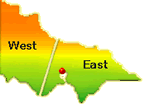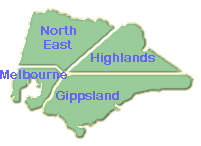|
Wilsons
Promontory
National
Park
Just
three
hours
from
Melbourne
is
one
of
the
finest
national
parks
in
the
country,
the
50,000
hectare
Wilsons
Promontory
National
Park.
Wilsons
Promontory
-
which
juts
out
into
Bass
Strait
-
constitutes
the
southernmost
point
of
the
Australian
mainland.
It
was
described
by
explorer
George
Bass
as
the
"cornerstone
of
this
continent
called
"New
Holland"
after
he
saw
the
Prom
in
the
first
days
of
1798.
Bass
named
the
area
Furneaux's
Land
but
it
was
later
renamed
in
honour
of
a
prominent
London
businessman,
Thomas
Wilson.
It
is
believed
Wilsons
Promontory
was
once
part
of
a
"land
bridge"
connecting
the
mainland
with
Tasmania.
In
another
age
the
Prom
is
thought
to
have
been
an
island.
The
gradual
build
up
of
a
20
kilometre
stretch
of
sand
dunes,
known
as
the
Yanakie
Isthmus,
is
said
to
have
reconnected
the
Prom
with
the
mainland.
The
Aborigines
who
once
lived
here
were
members
of
the
Boon-Oor-Rong
tribe
and
their
middens
are
still
evident
on
the
western
side
of
the
promontory.
Long
before
Bass's
official
visit,
the
area
was
frequented
by
sealers
and
whalers.
Whale
bones
can
still
be
seen
in
the
waters
of
Sealers
and
Refuge
Coves
on
the
eastern
side.
In
many
respects
it
is
still
much
the
same
as
it
was
at
the
time
of
Bass's
first
visit.
It
is
comprised
of
imposing
granite
mountains,
sweeping
plains,
thick
forests
and
some
of
the
finest
beaches
in
the
country.
These
range
from
sheltered
little
coves
to
long
surf
beaches.
The
Prom
is
the
ideal
place
for
bushwalking
and
a
full
appreciation
of
the
magnificent
array
of
native
wildlife
Australia
has
to
offer.
The
friendliest
are
the
parrots
which
flock
around
anyone
offering
food
at
Tidal
River.
Tidal
River
is
the
"capital"
of
the
Prom.
It
is
made
up
of
an
information
centre,
museum,
caravan
and
camping
grounds
with
some
cabins.
Here
you
will
find
a
cairn
which
acknowledges
the
use
of
the
Prom
as
a
commando
training
camp
during
World
War
II.
Tarra
Bulga
National
Park
Just
north-west
of
Yarram
is
the
famous
Tarra
Bulga
National
Park.
It
takes
its
name
partly
from
the
Aborigine
Charlie
Tarra
who
accompanied
explorer
Paul
Edmund
de
Strzelecki
through
the
area
in
1840.
Strzelecki's
party
would
have
perished
if
not
for
the
hunting
skills
of
Tarra.
The
park
is
the
veritable
jewel
in
the
crown
of
what
the
locals
call
Tarra
Territory".
The
park
is
comprised
of
two
sections
-
Tarra
and
Bulga.
These
lush
areas
of
rainforest
are
all
that
remain
of
a
great
forest
of
trees
which
at
one
time
covered
all
of
Gippsland.
Noted
for
their
towering
mountain
ash
and
thick
cover
of
ferns,
both
sections
of
the
park
are
linked
by
the
Grand
Ridge
Road.
The
Park
has
plenty
of
walking
tracks,
a
picnic
area
and
a
host
of
wildlife,
including
the
remarkable
lyrebird.

|


